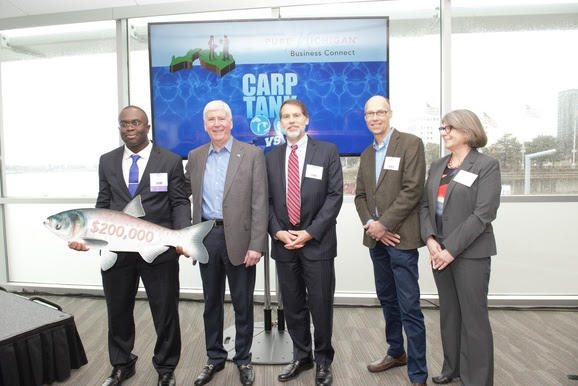Michigan: Gov. Rick Snyder awards $500,000 to Carp Tank innovation challenge winners

DETROIT, Mich. – Governor Rick Snyder Tuesday announced the grand prize winner of the Great Lakes Invasive Carp Challenge. The solution proposed by Edem Tsikata, a software consultant at Harvard Medical School in Boston, Massachusetts, received the top award at the Carp Tank competition held Tuesday at the Port Authority in Detroit.
Tsikata’s “Cavitation Barrier to Deter Asian Carp” would utilize a row of specially designed propellers to generate a wall of cavitation bubbles that implode and emit high-speed jets of water. The painful sensation of the bubbles along with the noise of the propellers would repel fish and prevent their passage beyond the bubble barrier.
“I applaud the innovative solutions these finalists presented today, and congratulate Edem Tsikata for winning the challenge,” Snyder said. “Blocking Asian carp from entering the Great Lakes is critical, and Michigan can’t afford to wait any longer. I’m confident that the solutions presented today will help take us one step closer to ensuring our waters remain free of this dangerous and harmful invasive species.”
Tsikata was selected from four finalists who presented their ideas to a panel of judges and a live audience of invasive carp researchers, fisheries managers and venture capitalists. Tsikata plans to use his $200,000 award to invest in other projects and future challenges.
“It was thrilling to be associated with a project benefitting Michigan and the Great Lakes,” Tsikata said. “It’s gratifying to be able to contribute ideas that benefit the economy and ecology of this region even though I live in Boston.”
The Carp Tank competition is the culmination of the Great Lakes Invasive Carp Challenge, which invited innovators from around the world to develop methods to prevent invasive carp from entering the Great Lakes. Gov. Snyder announced the challenge in February 2017 and solutions were accepted through crowdsourcing leader InnoCentive’s Challenge Center from August through October 2017.
Gov. Snyder was joined at the judge’s table by Dr. Denice Shaw, Senior Innovation Advisor for the U.S. Environmental Protection Agency’s Office of Research and Development; Jeff DeBoer, Vice President and Chief Innovation Officer at Sundberg-Ferar, Inc. and chairman of the Michigan Design Council; and Dr. David Lodge, an international expert on invasive species and Director of Cornell University’s Atkinson Center for a Sustainable Future.
Judges assessed each proposal based on its potential effectiveness, feasibility, environmental and human impacts, and level of innovation.
A second-place award of $125,000 was given to David Hamilton, Senior Policy Director for The Nature Conservancy in Lansing, Michigan
Hamilton’s “AIS Lock Treatment System” is designed to function in a lock system. After vessels are moored in a gated chamber, a carefully measured amount of chlorine – which is lethal to a wide range of aquatic organisms, including invasive carp – would be injected and mixed into the chamber’s waters. Following treatment, sodium bisulfate would be used to detoxify the water before it is released into the river.
Michael Scurlock, a hydraulic engineer with RiverRestoration in Carbondale, Colorado, garnered third place and $100,000 for adjustable physical velocity barriers designed to concentrate water flow in a lock system after vessels are moored, creating a current that fish cannot swim against and essentially flushing the system before the lock gates are closed.
Dr. D.J. Lee of Smart Vision Works International in Orem, Utah, also a professor and director of the Robotics Vision Laboratory at Brigham Young University, took fourth place with his Recognition and Removal of Invasive Fish. Lee received the fourth-place award of $75,000. His solution is designed to prevent invasive carp from moving past the installation point by directing all fish through an automated imaging and sorting system that uses unique recognition software to divert invasive carp to a holding area for harvest.
To learn more about Michigan’s efforts to Block Asian carp, visit www.BlockAsianCarp.org.
Contacts:
Governor’s Office: Jordan Kennedy
517-335-6397
DNR: Ed Golder
517-284-5815







